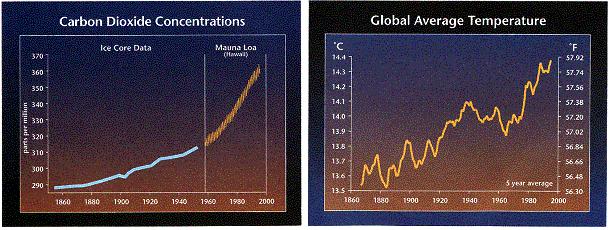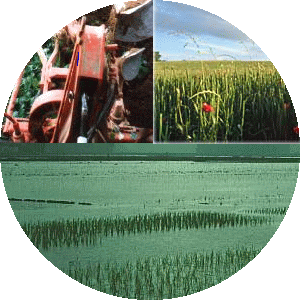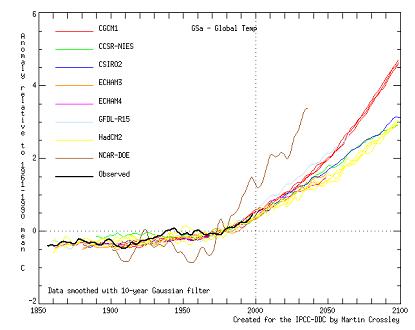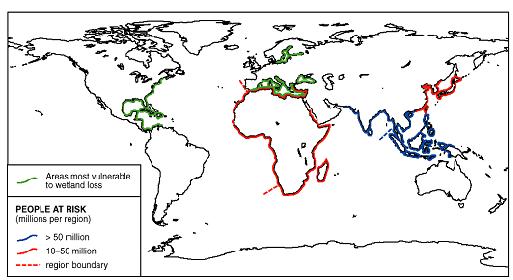 > English > Climate Encyclopaedia > Food and Climate > more > 2. Predicting the future > - global change
> English > Climate Encyclopaedia > Food and Climate > more > 2. Predicting the future > - global change
|
|
From industrial development to global changeBy burning fossil fuels and cutting down forests, human activity has caused carbon dioxide (CO2) concentrations in the atmosphere to increase by around 25% since the industrial revolution. This increase continues today.
|
|
CO2 and other greenhouse gases such as water vapour, methane and nitrous oxide trap infra-red radiation coming from the surface of the Earth and reduce the amount of heat lost into space. This process occurs naturally and without it our planet would be freezing. This greenhouse effect warms the Earth to its current average temperature of about 15ºC.
|
 |
|
1. Measurements made on Mauna Loa in Hawaii since 1956 reveal the recent CO2 trend. Source IPCC. |
The enhanced greenhouse effectThe concern now is that human activities are causing the natural greenhouse effect to be augmented, leading to significant increases in average temperatures and related changes in the entire climate system. Has global warming actual begun? When we look at the Earth’s global average temperature over the last century, we see that temperatures have risen about 0.5ºC. The 1990's is the warmest decade on record. Whilst it is difficult to prove conclusively that rising CO2 concentrations are causing the Earth to warm, scientists believe that the trends of increasing carbon dioxide and temperature are linked (IPCC, 1996a).
|
|
At least ten GCMs have been developed by atmospheric scientists and have been used to predict the effects of increased greenhouse gas concentrations on global climate. Results from these simulations show a mean global warming between 1.4 and 5.8 ºC by the end of the next century. If the models include sulphate aerosols, the models estimate a temperature rise of between 1.0 and 3.5 ºC by 2100. Sulphate aerosols both reflect incoming solar radiation back into space and also help to form clouds. Both processes reduce the amount of sunlight reaching the Earth and therefore cool our planet. Global climate models also predict an increase in average global rainfall ranging from about 5 to 20% because a warmer atmosphere can hold more water vapour.
|
|
GCM's further predict that: • High latitude regions (particularly the polar regions) and high elevations are likely to experience greater warming than the global mean warming, especially in winter. • Winter time and night time minimum temperatures will continue to rise faster than average temperatures. • The hydrological cycle is likely to further intensify, bringing more floods and more droughts. • More winter precipitation is predicted fall as rain, rather than snow. This will decrease snow pack and spring runoff, potentially worsening spring and summer droughts.
|
 |
|
3. Changes in temperature and precipitation. Source: NASA/GISS. This figure shows future changes in temperature (left) and precipitation (right) simulated with the Hadley Model for the year 2050. The changes are more severe in the later part of the century.
|
Sea level rise scenariosGlobal warming will also affect sea level. There have been a range of estimates for sea level rise based on greenhouse gas emissions and temperature projections that affect the expansion of the water in the oceans and glacial melting. Recent estimates suggest that average sea levels will rise by around half a metre by 2100. If you would like to know more about the causes and consequences of sea level rise have a look in the 'read more' section of the Oceans Topic.
|
|
Socio-economic ScenariosClimate is not the only factor that will change as the 21st Century unfolds. Population growth and changing economic and technological conditions are likely to affect world society and the environment even more than changes in climate. It is important to take such changes into account when we conduct climate change impact assessments. However predicting population growth rates and future economic conditions are equally, if not more, uncertain than predictions of future climate. A useful approach is to contrast "optimistic" and "pessimistic" views of the future. In the optimistic scenario, population growth rates are low, economic growth rates and incomes rise, environmental pollution decreases and land degradation abates. In the pessimistic scenario, population growth rates are high, economic growth rates and incomes are low, environmental pollution increases and land degradation accelerates. A scenario where nothing changes (i.e., present conditions remain) should also be included. The different effects of climate change on current conditions, and on these two alternative scenarios of the future can then be evaluated.
|
|
Related pages For more information on sea level rise have a look at:
|


